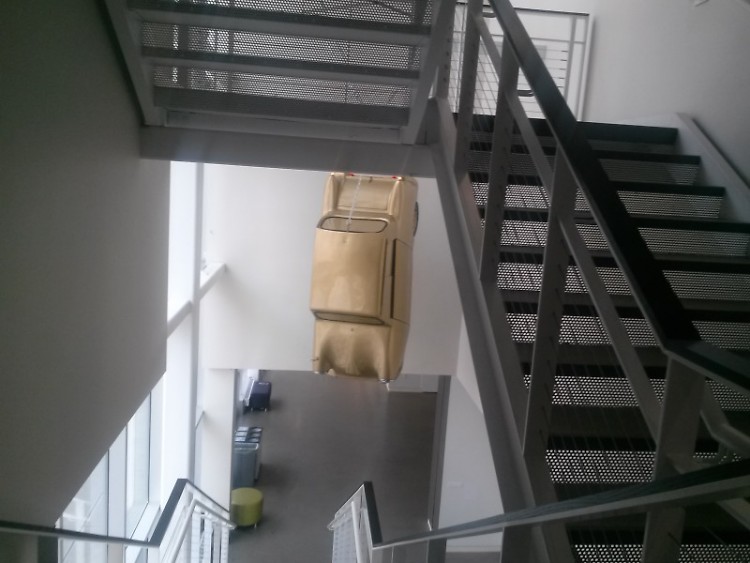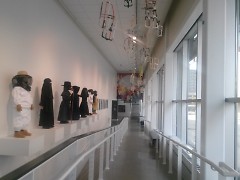When I heard about "Art of the Lived Experiment", the feature exhibit of the DisArt festival, I was curious as to how the Urban Institute for Contemporary Art (UICA) would adapt the exhibit- originally shown at Liverpool's DaDa Festival- across multiple venues. As I walked around the portion of the exhibit at the UICA, one phrase kept popping up in my notes: "Accessibility theater." In the same way that "security theater" at an airport only gives the impression of safety while traveling, the UICA only gave the impression of accessibility at the exhibit.
Ignition Failure
Evidently viewers are supposed to begin the exhibit at the "Ignition Room"-a space that includes artifacts and imagery about how disabilities were addressed in the past. Highlights include an early hearing aid and a short film featuring Flannery O'Connor's backwards-walking chickens. Is the "Ignition Room" the first thing the viewer sees upon entering the UICA? No. It's tucked away in a small room, past the entry ramp, by the first floor elevator. In fact, I walked past it and only experienced the "Ignition Room" after I'd seen the rest of the exhibit. If the "Ignition Room" is supposed to be the first thing visitors encounter, it should be the first thing they see upon entering the UICA. Then again, if the curators placed the artifacts of the "ignition Room" at the very front, they'd have to sacrifice vital space in the gift shop. Nothing says "accessibility" like crowding artifacts into a space only meant to be accessed by the able-bodied.
Ramps and Stairs
One of the first pieces that viewers do see is Laura Swansons "Uniforms," a series of photographs and "readymade uniforms" arranged along the wall alongside the ramp that goes to the first floor gallery. It's a striking display, so striking that people paused to take a closer look--which meant that the ramp was inaccessible to anyone using a wheelchair.
Almost every UICA exhibition includes a high-impact hanging sculpture, and this time it was "Gold Lamé," a repurposed Invacar by British artist Tony Heaton. During the 60's and 70's, small three-wheeled fiberglass "invalid cars" were distributed by the NHS to disabled people in England. In 2003, "invalid cars" were finally banned due to safety concerns. Kathleen Harris, reviewing the original exhibit for the BBC News OuchBlog praised Heaton for "transform{ing} one Invacar from 'spazz blue' to gold for this exhibition, turning an object of ridicule and little value into something of value."
How ironic that a symbol of isolation and inaccessibility is placed right next to the UICA's main staircase.
Do your research (or buy an iPhone)
If you hadn't done some background research on the original DaDa festival exhibit (like I did), or downloaded the new Access UICA app (which I didn't- it's not available on Android devices), you wouldn't know anything about the history behind "Gold Lamé" and might wonder what a hanging gold car is doing in an exhibit about disability. Apps can be incredibly helpful, but they should not be a replacement for providing basic background information and captions in your exhibit. 106 Gallery's DisArt exhibit, "Access Is A Civil Right: The Photography of Tom Olin" did an excellent job of providing the audience with the background history behind Olin's photos from numerous activist protests, no app required.
"Creativity In Madness"
My favorite piece in the exhibit at UICA is "Ship of Fools," a video installation by London performance artist with a vacuum cleaner, who turned their apartment into a treatment facility and creative workspace "in an attempt to find creativity in madness." The vacuum cleaner connects their experiences with depression and anxiety to the healthcare industry, law enforcement and the prison industrial complex, and even their mother's faith and spirituality. This installation should have been featured prominently, but instead was hidden away around the corner from the concessions stand.
"Art of The Lived Experiment" at the UICA is an example of how poor curation can diminish the impact of good art.
The Rapidian, a program of the 501(c)3 nonprofit Community Media Center, relies on the community’s support to help cover the cost of training reporters and publishing content.
We need your help.
If each of our readers and content creators who values this community platform help support its creation and maintenance, The Rapidian can continue to educate and facilitate a conversation around issues for years to come.
Please support The Rapidian and make a contribution today.


